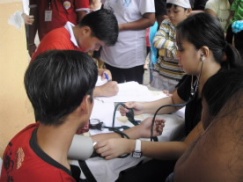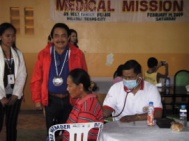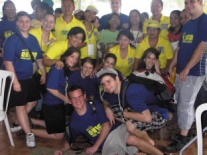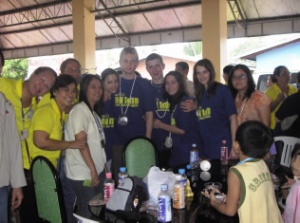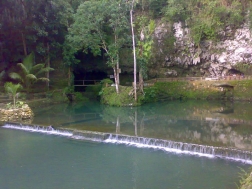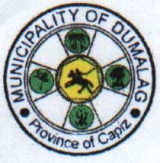
Panitan is a 4th class municipality in the province of Capiz, Philippines. According to the 2000 census, it has a population of 37,458 people in 7,073 households.
-
▼
2009
(132)
-
▼
February
(132)
-
▼
Feb 19
(31)
- Captivating Capiz: Pontevedra
- Captivating Capiz: Dao
- Captivating Capiz: Dao Transportation and Location
- Captivating Capiz: Dao Cultural Activities
- Captivating Capiz: Dao Religious Aspect
- Captivating Capiz: Pontevedra Balintawakan Festival
- Captivating Capiz: Dumalag
- Captivating Capiz: Dumalag Tourist Spots
- Captivating Capiz: Dumalag Parish Church
- Captivating Capiz: Gawad Kalinga Medical Mission i...
- Captivating Capiz: Tapaz
- Captivating Capiz: Tapaz Territorial Boundary
- Captivating Capiz: Tapaz History
- Captivating Capiz: Tapaz Official Seal
- Captivating Capiz: Tapaz OFFICIAL FLAG
- Captivating Capiz: Tapaz Motto
- Captivating Capiz: Tapaz Barangays
- Captivating Capiz: Sigma
- Captivating Capiz: Sigma Barangays
- Captivating Capiz: Sapi-an
- Captivating Capiz: Sigma Town Center
- Captivating Capiz: Sapian Barangays
- Captivating Capiz: President Roxas
- Captivating Capiz: President Roxas Barangays
- Captivating Capiz: Pontevedra
- Captivating Capiz: Pontevedra Barangays
- Captivating Capiz: Pilar
- Captivating Capiz: Pilar History and Culture
- Captivating Capiz: Pilar people and Economy
- Captivating Capiz: Pilar Barangays
- Captivating Capiz: Panitan
-
▼
Feb 19
(31)
-
▼
February
(132)
Blog Archive
Recent Viewers
Some resources of our articles!
my SEO!!
my SEO!!
Captivating Capiz - Roxas City Seafood Capital of the Philippines
Captivating Capiz - Roxas City Seafood Capital of the Philippines
Captivate and Experience the Beauty of Capiz
CAPIZ

Seafood Capital of the Philippines
Captivating Capiz: Panitan
Posted by : <-=[]group 3 hooke[]=-> on Thursday, February 19, 2009 | | 0 Comments
Captivating Capiz: Pilar Barangays
Pilar is politically subdivided into 24 barangays.
|
|
Posted by : <-=[]group 3 hooke[]=-> on | | 0 Comments
Captivating Capiz: Pilar people and Economy
Pilar is politically classified as a 4th class economy. Development in basic infrastructure has been stagnant during the last decades. Annual income is low and poverty rates are said to be high, although the town has also seen greater years. The rural municipality is said to be rich in natural resources such as aquatic and mineral wealth. It used to be a very strong seafood producer in the province and once even possessed its own sugar and mining industry.
Major agricultural products of the town include fish, prawn, crab, rice, sugar, cattle and poultry. The town also has its own Baptist Church and Iglesia ni Kristo Parish as wellas its own rural bank along the town market. Dulangan and Casanayan serve as satellite villages of the town.
Most of the town's population are made up by Austronesian descendants, followed by Aetas and a few of Chinese and Spanish ancestry.
Posted by : <-=[]group 3 hooke[]=-> on | | 0 Comments
Captivating Capiz: Pilar History and Culture
The coastal town sprang out from an Austronesian settlement in the early 16th century when indio natives managed to escape colonial tyranny from the Spaniards. The settlement was then known as Sibala, named after the river that ran through the coastal village. In 1570, however, the settlement was seized by Spanish colonial officials and the guardia civil took full control of the village. It later flourished into a bigger and prosperous town and was renamed after its designated patron saint La Nuestra Señora del Pilar ( Our Lady of the Pillar). Several friars and missionaries were assigned to preach in the town since then until it later received its permanent parish priest.
There had been a famous resistance called the Battle of Balisong during the Philippine Revolution in the 19th century as an attempt to overthrow Spanish officials in the municipality led by local revolutionaries Juan Arce and Dalmacio Patricio.
Today, an iconic 12-foot landmark of the Virgin Mary is visible at a mountaintop in Brgy. Dulangan, built by an affluent Chinese-Filipino merchant in honor of the town's patron saint, which is also said to have conducted miraculous powers to its devotees several times.
The town celebrates its annual feast along with the coming of the sacred Santisima Trinidad (The Holy Trinity), an early 18th century wooden figurine from Mexico found by local fishermen in the shores of the town during the British invasion of the Philippines in 1762. The figurine was said to be brought over to the Pacific by a Galleon trading ship from the port of Acapulco, Mexico which was destroyed by British warships during its route in Luzon and was washed off to the coast of Pilar. It is now still visible at the altar of the town's church, the Parish of the Most Holy Trinity.
The town is also known for its rich local heritage in mythology and folklore of legends and supernaturalism. The Legend of the Golden Shiptells the myth of a beautiful fairy that dwells in the caves of the town's mountainous forests and seduces young men every full moon wherein an illusionary lake appears inside the cave of Balisong and the mistress disappears with her victims in a golden ship along with the fading of the lake at sunrise.
Posted by : <-=[]group 3 hooke[]=-> on | | 0 Comments
Captivating Capiz: Pilar

Pilar is a 4th class municipality in the province of Capiz, Philippines. According to the 2000 census, it has a population of 38,903 people in 7,747 households.
Posted by : <-=[]group 3 hooke[]=-> on | | 0 Comments
Captivating Capiz: Pontevedra Barangays
Pontevedra is politically subdivided into 26 barangays.
|
|
Posted by : <-=[]group 3 hooke[]=-> on | | 0 Comments
Captivating Capiz: Pontevedra

Pontevedra is a 3rd class municipality in the province of Capiz, Philippines. According to the 2000 census, it has a population of 40,103 people in 7,673 households.
Posted by : <-=[]group 3 hooke[]=-> on | | 0 Comments
Captivating Capiz: President Roxas Barangays
President Roxas is politically subdivided into 26 barangays.
|
|
Posted by : <-=[]group 3 hooke[]=-> on | | 0 Comments
Captivating Capiz: President Roxas

President Roxas is a 4th class municipality in the province of Capiz, Philippines. According to the 2000 census, it has a population of 27,531 people in 5,119 households. Originally known as Lutod-Lutod, it received its present name after it broke away from the neighboring municipality of Pilar during the booming years of the sugar industry in the 1960's.
Posted by : <-=[]group 3 hooke[]=-> on | | 0 Comments
Captivating Capiz: Sapian Barangays
Sapian is politically subdivided into 10 barangays.
- Agsilab
- Agtatacay Norte
- Agtatacay Sur
- Bilao
- Damayan
- Dapdapan
- Lonoy
- Majanlud
- Maninang
- Poblacion
Posted by : <-=[]group 3 hooke[]=-> on | | 0 Comments
Captivating Capiz: Sigma Town Center
The town center
In the center of town is a well-maintained park known simply as the plaza. It is the venue of many celebrations especially during the town fiesta. People of Sapian show lavish cultural and religious celebrations from July 22 to 26 each year in honour of their patron saint Santa Ana.
Few meters away from the plaza is the municipal hall which holds local government offices. Next to it is the barangay hall and health clinic. Nearby is Sapian Elementary School, two big churches: the Catholic Church and the Aglipayan Church, and the public market.
About one kilometer from the town center is Sapian National High School and Capiz State University (CAPSU) Sapian Branch.
Posted by : <-=[]group 3 hooke[]=-> on | | 0 Comments
Captivating Capiz: Sapi-an
Sapi-an or Sapian is a 4th class municipality in the province of Capiz, Philippines. It belongs to the Second Congressional District of the Province of Capiz. The town's zip code is 5806.
On last count, Sapian has a total population of 25,316 people and 23,854 of the Sapianons are Catholics.
Sapian Bay which is situated in the northern part of the municipality is geographically joined with Capiz Bay. The 30 km² Sapian and Capiz shallow sea bays has extensive intertidal mudflats, sandy beaches, mangrove swamps, estuaries of several small rivers, and associated coastal lagoons and marshes.
Sapian Bay which opens up to the sea is a source of livelihood for many Sapianons. Marine produce from Sapian Bay include green mussels "tahong", oyster "talaba", lobster and different species of fish,and clams. Many lands near sea water were developed into fishponds that produce milkfish (bangus), prawns and crabs.
Another source of livelihood is agriculture. Carpets of rice fields, trees and flowers can be seen as one travels through Sapian along the national road which connect Roxas City to Iloilo and Aklan. The ricefield along the national road are slowly disappearing to give way to housing developments. Sapian's main agricultural produce are rice and coconuts.
Posted by : <-=[]group 3 hooke[]=-> on | | 0 Comments
Captivating Capiz: Sigma Barangays
Sigma is politically subdivided into 21 barangays.
|
|
Posted by : <-=[]group 3 hooke[]=-> on | | 0 Comments
Captivating Capiz: Sigma

Sigma is a 4th class municipality in the province of Capiz, Philippines. According to the 2000 census, it has a population of 27,366 people in 5,541 households.
Posted by : <-=[]group 3 hooke[]=-> on | | 0 Comments
Captivating Capiz: Tapaz Barangays
apaz is politically subdivided into 58 barangays.
|
|
|
Posted by : <-=[]group 3 hooke[]=-> on | | 0 Comments
Captivating Capiz: Tapaz Motto
The Municipal Motto of Tapaz shall be “Regnat Populus Dei” or “The People of God Reigns”. It means that the general welfare of the people (of Tapaz), under the guidance of the Almighty God, reigns supreme and is the guiding principle in public service and in local governance and public service.
Posted by : <-=[]group 3 hooke[]=-> on | | 0 Comments
Captivating Capiz: Tapaz OFFICIAL FLAG
OFFICIAL FLAG
DESCRIPTION AND MEANING OF THE NEW FLAG (Designed by Peter Marlon H. Exmundo with inputs from Mayor Romualdo G. Exmundo, Jr., MD, and Mr. Leorico Fundal of SNNHS)
1. Head of a Deer — The head of the Philippine Spotted Deer, a deer that is endemic in Western Visayas, particularly in the central region of Panay Island (but gradually becoming extinct and given by the DENR a conservation status of IUCN (EN)), with the scientific name of Cervus alfredi, has always been the unique symbol of Tapaz. Symbolizing the once rich fauna and wildlife of Tapaz, it also symbolizes the indigenous people and cultural heritage of Tapaz. The head has eight horns, four on each antler. Two of the horns, one on each antler, are small buds. In Chinese Astrology, the deer, being a swift and agile animal, symbolizes better economic growth and opportunities. The number eight symbolizes continuity and prosperity in the Chinese beliefs. The two small developing horns also symbolize growth. The seasonal shedding and regrowing of the antlers symbolize eternity and constant renewal of the municipality towards progress and development. The deer is facing east where the sun rises 2. Stars — The two groups of twenty-nine six-point gold stars parallel to the top and bottom borders symbolizes excellence and the component barangays of the municipality. The circle of Fifty-eight six-point gold stars along the inner border of the seal symbolizes the component barangays of the municipality. The six-point star is also known as the Star of David and by its Jewish Name, Mogen David (Shield of David). Its use in the flag of the municipality is our affirmation of our Christian faith and heritage, considering that Jesus Christ belongs to the house of King David of Israel. The Star of David is also the symbol Judaism, the elder religious brother of Christianity. 3. Golden Laurel Leaves — Beneath the fifty-eight gold stars are two golden laurel branches and a golden camia flower (family = Zingiberaceae, Scientific Name = Hedychium Philippinese) at the center. The design is similar to the laurel branches and camia flower in the seals of the Mayor and Vice Mayor. They represent the local government of Tapaz as well as the national and provincial government agencies operating in the municipality. 4. Caption — A banner with a yellow background and orange border with the Phrase TAPAZ, CAPIZ using the Bangle font is written on it is placed over the head of deer to let everyone knows that this flag belongs to Tapaz. 5. The Green Background — The background symbolizes the farming community, which is the primary source of livelihood in the municipality.
SIZE RATIO: (A) The length of the width should be twice the length of the height for a width-height ratio of 2:1. (B) For a 2 x 1 meter flag, the height and width of the star is 6 cm x 5.3 cm. The distance from the top and bottom edges of the border is 12 cm.; (C) The height of the head of the deer from the tip of the antler to the base of the neck is 33.55 cm and the width from the tip of the nose to the deep of the left ear is 21.45 cm. (D) The height of the antler from the tip to the base on top of the head is 13.71 cm. (E) The length of the snout from the tip of the nose to the corner of the snout and the neck is 8.71 cm. (F) For the golden branches of laurel leaves, the length is 31.13 cm and the width is 6.75 cm. (G) For the banner above the deer, the width is 5.16 cm, the length excluding the side pennants on which is the captions are placed is 31.97 cm, and the total length is 39.03 cm.
OVERALL MEANING OF THE NEW FLAG
THE FLAG OF THE MUNICIPALITY was redesigned to give it more meaning and reflect the identity of the Tapaznons. With the new flag we discarded the traditional and common method of simply placing the seal of an agency or of a local government unit in the middle of a rectangular cloth, place two holes along the left border, and tussles along the perimeter to make an instant flag. Instead, we only use the relevant symbols and strategically arrange them along the banner
Despite of the suggestion of some persons to discard the head of the Philippine Spotted Deer in the design of the new seal and flag as an obsolete emblem and relic of a bygone era and that a new one reflective of contemporary and future generations should be adopted, we have decided to retain it for the relevance of its meaning to our identity as Tapaznons. Its retention is a sign of our respect, linkage with, and honoring our past, our traditions, and our cultural heritage — it should remind us of the words of our National Hero, Jose Rizal, when he said “Ang Taong Hindi Marunong Lumingon sa Kanyang Pinanggalingan ay Hindi Makakarating sa Kanyang Paroroonan” — and as a reminder to us of our once pristine and lush flora and fauna. However, we accommodated the suggestions of some notable persons to redesign it to make look more like the deer in our hinterlands. Together with the meaning of the symbolism of the deer, by redesigning it and adding other emblems to it to enrich its meaning, we are also signifying our desire for change and to move forward towards progress and development.
The government/public service/sector, the community/barangays and our Christian faith and heritage, and our principal means of livelihood/the private sector, symbolized by the laurel leaves and camia flower, the stars, and the background, respectively refers to us collectively as Tapaznons.
The banner with the caption “Tapaz, Capiz” crowns the flag, because it symbolizes our pride to be part of the Municipality of Tapaz, in the Province of Capiz and to be called Tapaznons and Capiznons.
Posted by : <-=[]group 3 hooke[]=-> on | | 0 Comments
Captivating Capiz: Tapaz Official Seal
OFFICIAL SEAL
OFFICIAL DESCRIPTION AND MEANING OF THE SEAL UNDER MO 16-01 (Designed by Peter Marlon H. Exmundo based on the general specifications of Mayor Romualdo G. Exmundo, Jr., MD, with inputs from Nona G. Vista, Engr. Victorio Jimenez and Ma. Theresa G. Nepomuceno)
1. Mountain Ranges — The two twin-peak mountain ranges symbolizes the hinterlands and tropical forests of Tapaz and the location of Tapaz at the heart or center of Panay Island. 2. River — the River at the center of the two mountain ranges symbolizes the three largest river systems in the Island of Panay that begins in Mt. Nacuron, in Brgy. Hilwan, a hinterland barangay of Tapaz. Panay River, a 152-kilometer long river feeds the 230,587-hectare Panay River System in the Province of Capiz, or almost 88% of the total land area of the province. Aklan River flows to the Province of Aklan and feeds the Aklan River System in the Province. Both rivers share the same stream in Mt. Nacuron. One of the major streams feeding the main stream feeding Jalaur River, which is located in Calinog, Iloilo, is located in Mt. Nacuron. Jalaur River, feeds the Jalaur River System in the Province of Iloilo. 3. Head of a Deer — The head of the Philippine Spotted Deer, a deer that is endemic in Western Visayas, particularly in the central region of Panay Island (but gradually becoming extinct and given by the DENR a conservation status of IUCN (EN)), with the scientific name of Cervus alfredi, has always been the unique symbol of Tapaz. Symbolizing the once rich fauna and wildlife of Tapaz, it also symbolizes the indigenous people and cultural heritage of Tapaz. The head has eight horns, four on each antler. Two of the horns, one on each antler, are small buds. In Chinese Astrology, the deer, being a swift and agile animal, symbolizes better economic growth and opportunities. The number eight symbolizes continuity and prosperity in the Chinese beliefs. The two small developing horns also symbolize growth. The seasonal shedding and regrowing of the antlers symbolize eternity and constant renewal of the municipality towards progress and development. The deer is facing east where the sun rises. 4. Branch of Leaves — The branch of leaves at the left mountain range symbolizes farming, the chief industry and source of income of Tapaz. As a branch of laurel leaves, it also symbolizes the dignified role of the farmers in our country and the excellent contributions of the Tapaznons in national and international development. 5. The Morning Sun — The morning sun, which is placed at the center of the two mountain ranges, as it rises over the east to begin a new day with its seven rays symbolizing hope and faith for a better future. It also symbolizes our unity with our Filipino brothers and sisters, because the morning sun, which is notable in most Asian flags and seals, symbolizes the sun rising from the East. The number seven is also a mystical and lucky number in most cultures and beliefs. For the Jews, the number seven is the symbol of perfection, thus we have the seven cardinal virtues, the seven beatitudes and the seven habits of highly successful people. Its seven rays symbolize the seven cardinal virtues, and the seven beatitudes 6. The Bird — the bird, specifically the dove, traditionally symbolizes The Holy Spirit. Love and bravery are traditionally symbolized by the color red. The red silhouette of the bird flying in the center of the morning sun symbolizes the spirit of bravery, peace and love living in every soul of each Tapaznon, nourished by the Holy Spirit. However, in the seal the bird is not just a dove but also a parrot or tikoy the official bird of the municipality (which is found in the hinterland of Tapaz and whose number is fast depleting). Its common name in English is “Blue Nape Parrot” and its scientific name is “Tanygnathus luzonensis”. It is placed in the center of the sun and the mountain peaks as a symbol of our unity as Tapaznons under the inspiration and guidance of the Holy Spirit. The bird is facing east where the sun rises. 7. The Blue Background — The background, which is sky blue, symbolizes the clear sky over Tapaz. The color sky blue is usually attributed to the Blessed Virgin Mary, the mother of Jesus, and as the color of the Immaculate Conception, the Patroness of the Province of Capiz. 8. Stars — The circle of Fifty-eight six-point gold stars along the inner border of the seal symbolizes the component barangays of the municipality. The six-point star is also known as the Star of David and by its Jewish Name, Mogen David (Shield of David). Its use in the seal of the municipality is our affirmation of our Christian faith and heritage, considering that Jesus Christ belongs to the house of King David of Israel. The Star of David is also the symbol Judaism, the elder religious brother of Christianity. 9. Captions — The seal is surrounded by the following captions: “SAGISAG NG MUNISIPYO NG TAPAZ” (color blue using Bangle as font) and “LALAWIGAN NG CAPIZ” (color red, using Bangle as font). The use of Tagalog or Filipino in the captions symbolizes the unity of the Tapaznons with the Filipino people. The blue and red colors of the captions are the two main colors of the Philippine flag and seal. 10. Numbers — Dividing the two captions are the numbers “1874” and “2005” in gold or yellow orange color. 1874 was the year Tapaz was separated from Dumalag with the appointment of Don Pedro Gimeno as our first local chief executive, which is called at that time as Capitan Mayor, and Padre Jose Aparicio as our first parish priest; and 2005 was the year the new seal was adopted.
OVERALL MEANING OF THE NEW SEAL
THE SEAL OF THE MUNICIPALITY was redesigned to give it more meaning and reflect the identity of the Tapaznons. With the new Seal we added new symbols and arrange them accordingly along the seal as described above to reflect the true identity of the Tapaznons. Despite of the suggestion of some persons to discard the head of the Philippine Spotted Deer in the design of the new seal and flag as an obsolete emblem and relic of a bygone era and that a new one reflective of contemporary and future generations should be adopted, we have decided to retain it for the relevance of its meaning to our identity as Tapaznons. Its retention, together with the number “1874”, the year Tapaz was separated from Dumalag, are signs of our respect, linkage with, and honoring our past, our traditions, and our cultural heritage — it should remind us of the words of our National Hero, Jose Rizal, when he said “Ang Taong Hindi Marunong Lumingon sa Kanyang Pinanggalingan ay Hindi Makakarating sa Kanyang Paroroonan” — and as a reminder to us of our once pristine and lush flora and fauna. However, we accommodated the suggestions of some notable persons to redesign it to make it look more like the deer in our hinterlands. Together with the meaning of the symbolism of the deer, by redesigning it and the number “2005”, the year the new seal was adopted, we are also signifying our desire for change and to move forward towards progress and development. The community/barangays and our Christian faith and heritage, our location in the middle of the Island of Panay, the clear blue skies above us, our principal means of livelihood/the private sector, and our values symbolized by the stars, the twin mountain ranges and the river, the blue background, the branch of laurel leaves, and rays of the sun and the red silhouette of the bird respectively refers to us collectively as Tapaznons. The captions and their blue and red colors is our affirmation of our love for our municipality, province and country and our pride to be part of the Municipality of Tapaz, in the Province of Capiz, of the Republic of the Philippines, and to be called Tapaznons, Capiznons, and Filipinos.
ADDITIONAL AND UNOFFICIAL (NOT PART OF MO 16-01) MEANING OF THE SEAL
MYSTICAL MEANING OF THE NEW SEAL
IF YOU WILL EXAMINE CLOSELY THE SEAL you will find new symbols and meaning to the seal. These symbols were just discovered later, some of then after the Seal was already presented to the public and was in general use by the municipal government and some agencies within the municipality and some a few weeks after the enactment of the Proactive Administrative of Code under Municipal Ordinance No. 16-01 on 14 September 2005. The six-point star or hexagram was placed there for its originality to give Tapaz a star different from the rest. It should be noted that most are using the five-point star or the pentagram in their symbols. About two weeks before the enactment of MO 16-01, the author realized that the hexagram is the Star or Shield of David. Sometime in November 2005, it came to the knowledge of the author that the hexagram is the Jewish equivalent of the Chinese (originally Taoist) “Yin and Yang”, the symbol of universal and cosmic harmony and balance. By surrounding the seal, they provide harmony and balance in municipality. The hexagram is the unity of the pyramid, symbolizing the male or the positive force or energy of nature and the vessel (the reverse pyramid), symbolizing female or negative the negative force or energy of nature. The positive and negative energies balance each other thus providing harmony in nature and in the universe. The twin mountain peaks, shaped like pyramids and the v-shaped valley in between them are symbols of the “Yin and Yang”, though they are placed side by side instead of overlapping. From the valley (the vessel) contains the rising sun with its seven (the mythical perfect number) rays as it reinvigorates, renews, and brings us hope and faith for a better future with the red silhouette of the bird of peace and love. These virtues become the source of life, strength and nourishment as they flow from the vessel symbolized by the river (water) flowing from the base of the valley and continuously refreshed by the loving guidance and intercession of the Blessed Virgin Mary, the mother of Jesus, and as the color of the Immaculate Conception, the Patroness of the Province and Archdiocese of Capiz, as symbolized by the blue sky. The meaning of the deer and the branch of leaves completes the mysticism of the meaning of the seal. These symbolisms can also be interpreted in a Christian perspective. The mountains and the sky symbolize our unity with Christ, our Savior and our Creator. This unity is manifested by the Divine graces, virtues, and blessings (the sun and the bird) contained in the vessel or chalice (the valley), which eternally (represented by the seven rays of the sun) flow out (represented by the river) to us to cleanse, nourish, and reinvigorate us, wherever we are (represented by the 58 stars symbolizing the 58 barangays) and whoever we are (represented by the deer, symbolizing the indigenous people). The symbolism of the deer is unintentionally similar to the “Moor of Freising” in the Coat of Arms of Pope Benedict XVI. Together with our reverence and care with His creation (represented by the color green and the branch of laurel leaves, which also symbolizes excellence and the greatness of these graces and unity), by being united with Christ and sharing in His perfect (represented by the number seven) and unlimited love in unity with Mary, His Blessed Mother (represented by the color blue of the sky), our unity with our Filipino (represented by the Captions and the colors blue and red) and Asian (the sun rising from the east) brothers and sisters, and our reverence to our ancestors and pride of our historical heritage (both represented by the number 1874), and our concern for the welfare of the future generations (represented by the number 2005 and the antlers of the deer) universal harmony (symbolized by the hexagram) reigns.
Posted by : <-=[]group 3 hooke[]=-> on | | 0 Comments
Captivating Capiz: Tapaz History
Tapaz was founded in 1835 but it continued being a part of Dumalag for many years. In 1862 and 1863 two letters were made to declare parish under the patronage of St. Jerome. Both were signed by Governor General Lemery, but they were never executed. Finally, in 1874, Tapaz was declared an independent parish by Jaro Bishop Mariano Cuartero.
Posted by : <-=[]group 3 hooke[]=-> on | | 0 Comments
Captivating Capiz: Tapaz Territorial Boundary
a. Location — Tapaz lies within the latitude 11º 09’ to 11º 09’ 42” and the longitude of 121º 11’ to 122º 34’ 45”. b. Basic Description It is bounded on the northwest and northeast by the Municipality of Jamindan in the Province of Capiz, on the north by the Municipality of Libacao of the Province of Aklan, on the east by the Municipality of Dumalag of the Province of Capiz, on the west by the Province of Antique, and by the Province of Iloilo, principally by the Municipalities of Janiuay, Lambunao, Calinog and Bingawan from the Southwest to the Southeast.
Posted by : <-=[]group 3 hooke[]=-> on | | 0 Comments
Captivating Capiz: Tapaz

Tapaz is a 3rd class municipality in the province of Capiz, Philippines. According to the 2000 census, it has a population of 44,085 people in 8,739 households.

Posted by : <-=[]group 3 hooke[]=-> on | | 0 Comments
Captivating Capiz: Gawad Kalinga Medical Mission in Capiz with the Seebach Jubla
The Gawad Kalinga (GK) Medical Mission was held at the Holy Family GK Village (HFGKV) in Milibili, Roxas City last
February 14, 2009. It was supported by the Capiz Provincial Government. The medical mission’s purpose was to look out and take good care of all Capizeños for a better health.
It started with an invocation led by Mr. Rito Victoriano, the GK Management Board (GKMB) – Values Formation Head and a welcome message from Mr. Roy Donato, the Couples for Christ (CFC) Provincial Area Director. Mr. Mert Rosano, the GK Provincial Coordinator, reported updates about the HFGKV. He said that the last medical mission was held in 1996. Governor Victor A. Tanco, Sr. and Mayor Vicente B. Bermejo were also present. Mrs. Judy A. Roxas came in behalf of Senator Mar Roxas who donated 4 houses for the GK.
The participants were the GK Caretaker team, the Capiz Visitors and Convention Bureau (CVCB) and 16 Swiss nationals of the Seebach Jubla - a youth association based in Switzerland. They wanted to see for themselves the 46 houses that they have donated. There were 4 houses left for them to paint. Mr. Alex Gonzales, a deacon of Ma. Lourdes Parish in Zurich, Switzerland, facilitated donations from them.
Free medical check-up was conducted among 515 patients of all ages by Dr. Ramon Nolasco, Dr. Hector Flores, Dr. Jonacel Arceño and Dr. Donalyn Bonites. Food was distributed to the volunteers and medicine for the patients. The volunteers came from different sectors of the community. GK t-shirts were sold for P100 to support the organization.
The medical mission lasted the whole morning and was a success even it was raining. Milibili was located outside Roxas City and it was an unforgettable experience especially for the 16 Swiss nationals. Only a few of them knows how to speak in English but they enjoyed painting the houses.
The best part was that the poor have received health benefits during Valentines Day. There were a total of 60 houses built and through the Gawad Kalinga, the poor have felt love that will motivate them to live with integrity.
Author - Sheilla May O. Baes
Posted by : <-=[]group 3 hooke[]=-> on | | 0 Comments
Captivating Capiz: Dumalag Parish Church
Dumalag Parish Church
Another tourist attraction in Dumalag is the Dumalag Parish Church under the Patron St. of Saint Martin de Tours. The first church and convent of Dumalag were constructed between 1600 and 1720, and the parish was dedicated to Saint Martin of Tour, a bishop. In 1833 Fr. Augustin Duran, whose name has been adopted by one of the Dumalag’s biggest Barangays, started the construction of present church. The church had a five story bell tower which rose majestically at the left side of the church.
The church made of yellow sandstone, is 70m and 18m wide. It has two doors at the side and one in the front. Small pilasters decorate the facade wall. Six engaged rectangular pilaster rise up to the triangular pediment. The five story bell tower rises gracefully by the left side of the church.
Posted by : <-=[]group 3 hooke[]=-> on | | 0 Comments
Captivating Capiz: Dumalag Tourist Spots
Tourist Spots
Explore its captivating natural tourist spots; go spelunking in the cathedral-like Suhot Cave, take a shower among the falls of Nabayi and take a dip cool water of Masinalom, traced the history from the seat second Spanish and American settlement.
SUHOT SPRING
The leading natural attraction of Dumalag is the Suhot Spring and caves being marked by the towering Panginraon Range. The natural bridge and the famed caves of Suhot lead into minimally explored caverns which are claimed to stretch as far as the other side of  Panginraon, facing Dumarao, a neighboring municipality. The foot of legendary Panginraon Mountain, just 300 meters from the town proper. Surrounded by lush vegetation and second - growth forest, the cave strecthes 18 kilometers. Its innermost recesses and labyrinthine passages have remained unexplored.
Panginraon, facing Dumarao, a neighboring municipality. The foot of legendary Panginraon Mountain, just 300 meters from the town proper. Surrounded by lush vegetation and second - growth forest, the cave strecthes 18 kilometers. Its innermost recesses and labyrinthine passages have remained unexplored.
It is considered one of the longest caves in the country and has late been drawing amateur and seasoned spelunkers. The body of water in front of the cave is rich in minerals and originates from the watersheds of Panginraon.It flows through a subterranean passage and empties through the cave’s bowl-like opening guarded by a wall of solid rock.
The many chambers of the Suhot Caves are growing over with
stalactites and stalagmites of considerable sizes and lengths. At the mouth of the caves, near the natural brigde, is a spring with sulfurous, salty water that is consideres by the local folks as healthy for bathing. Suhot Spring and caves have become a favorite destination for people coming from other places visiting Dumalag.
Posted by : <-=[]group 3 hooke[]=-> on | | 0 Comments
Captivating Capiz: Dumalag
Dumalag is a 4th class municipality in the province of Capiz, Philippines. Dumalag is located by the slopes of several mountains on hilly But fertile land irrigated by the Panay and Malisbug rivers and other rivulets. It is bounded by Dao, Dumarao, Cuartero, Calinog and Tapaz. Dumalag is politically subdivided into 19 barangays
Concepcion
Consolacion
Dolores
Duran
San Agustin
San Jose
San Martin
San Miguel
San Rafael
San Roque
Santa Carmen
Santa Cruz
Santa Monica
Santa Rita
Santa Teresa
Santo Angel
Santo Niño
Santo Rosario
Poblacion
Dumalagnon’s unique brand of hospitality in the spirit of sharing the bounty of its natural resources.
Dumalag one of the central towns of Capiz province. The name Dumalag came from the Bisayan word” dalag” which mean yellow. Others claim that the “dalag” came from the color of the Pan-ay River that cuts across the town which is used to turn yellow because of the leaves of the certain tree. Another term is also “dumalaga” or spring chicken which could have been in abundance in the area in early times.
Dumalag is typical small town in Capiz. People know and great one another by name. Seeking directions to reach the places that brought them to the idyllic town, 35 kilometers from Roxas City. Dumalag is located in between of Cuartero and Tapaz. Their source of income came from rice planting and selling vegetable. Their works are farmers, fisherman and vendors.
Posted by : <-=[]group 3 hooke[]=-> on | | 0 Comments
Captivating Capiz: Pontevedra Balintawakan Festival
Balintawakan Festival
The people of this fast growing town of Pontevedra, Balintawak, a simple gathering begun on December31. In this month, people are drawn to the town public market to portable on an affair expressed largely through a “Binayle” and an instant search for Miss Balintawak.
Balintawak, as it became widely known in the community, derived its name from the Filipina dress or costume the ladies were required to wear that historical night and has become impliedly official attire.
Posted by : <-=[]group 3 hooke[]=-> on | | 0 Comments
Captivating Capiz: Dao Religious Aspect
Religious Aspect
The people of dao are most Roman Catholic. There are 47 chapels in the whole town. Different religious organization has been organized like the Knight of Columbus, Catholic Women League, Legion of Mary, Confraternity of Our Lady Lourdes, the Sa Maria, Couples for Christ,Marriage Encounter,Charismatic. The members of these organization are very active in any of their activities,projects ofr programs,which shows that the Daonhons are religiously committed.
Posted by : <-=[]group 3 hooke[]=-> on | | 0 Comments
Captivating Capiz: Dao Cultural Activities
Cultural Activities
It is the custom and tradition of the Daonhons to celebrate their religious fiesta every September 21 to 22 in honor of Patron Saint, St. Thomas of Villanueva. Fiestas is every barangays are also celebtrate by the barangay folks. During the month of May, Santacruzan is celebrated with the parade around the poblacion.
Posted by : <-=[]group 3 hooke[]=-> on | | 0 Comments
Captivating Capiz: Dao Transportation and Location
Location,transportation
The municipality of dao is one of the sixteen municipalities in the province of capiz. Its exact location is at coordinates 11 23 minutes - 8 seconds north latitude,122 40.9 minutes north longitude. It occupies the middle section of the Province of capiz and bounded by the municipality of Maayon on the east,municipality of Cuartero on the south,municipality of sigma on the northwest and on the northeast by the municipality of Panitan.
The town proper is located 33 kilometers from Roxas City. It consist of 20 barangays with the total land area of 8,640 hectares.
Posted by : <-=[]group 3 hooke[]=-> on | | 0 Comments
Captivating Capiz: Dao
Captivating Capiz-Dao,..Several years after the purchase of Madia-as(Panay) by datu puti from the Negrito Chief Marikulo, the malay Chiefs Sumakwil, Bangcaya and their “Sacup” started to establish settlement in the different parts of the island. Bangcaya was assigned to rule the Aklan Valley, (now Capiz) and designated his followers to settle in some parts of the distant places following the course of the river.
The municipality of Dao starts during the coming of the spaniards the town folks asked the name of the town in spanish,not understanding a word,they pointed to a nearby tree in the middle of the plaza and shouted “Dao,Dao” from then on the spaniards called a place “Dao”.
The spaniards imposed their to influence the heads of the barangays in collecting taxes they were called cabesas de barangay. In the years later, Cabesa by the name of Luis dela Concepcion was designated and was friendly with the spaniards. Concepcion was the first captain of the town.,Other who followed were:Don Felipe Isada,Don Francisco de la Concepcion,Don Agustin Salomeo and many more.
During Aguinaldo’s regime,the American detachment commander as president of the town appointed captain Bauson,Don Luis Escutin later succeded him. When the municipal president became an elective position,Don Leonardo Lumbo was the first man to hold the presidential post. He was succeded by Don Severo Abad,Don Felix Avelino,Don Marcos Lacerna etc,of all the town chief Executives,Don Jose Bauson stayed the Longest in the post almost a quarter of the century.
Posted by : <-=[]group 3 hooke[]=-> on | | 0 Comments
Captivating Capiz: Pontevedra
In 1853, the town Pontevedra was established at the present site of Barangay Sublangon. Formerly this town was a part of Panay, being the first settlement in the province of Capiz. Only in the year 1853 when General Crespo passed a decree making it independent town from Panay. Three years after, the town leaders decided to transfer the Poblacion to its present site because of the accessibility to the mouth of the big and navigable Agbalo river. The natives of the town call the place “Caguyuman”, a term descriptive of the place of ants or “ant hill”. This has been so because during that time the market days of the town attracted very large number of people from neighboring town and far away places. These people came to town like swarm of ants, on foot, bullcarts in bancas and sailboats. Hence the name was “Caguyuman” The name was changed to Pontevedra when the town has its own independent parish. That was 24 years later, after the town was established through the request of General Mariones. The request was granted two years after and Father Gregorio Hermida was the first Spanish Friar to take charge of the town parish. This Spanish Friar found the stiking resenblance of the town with that of his hometown in Pontevedra, spain. Henceforth through his influences the town was named PONTEVEDRA.
Captivating Capiz-PONTEVEDRA MUNICIPALITY In history as of this present time, according to the people there, Pontevedra before known as“CAGUYUMAN” meaning a group of people. Because during the day of monday and friday time ago until now people from their defferent Barangays, are going to the market on that days. Bringing their products and exchanging for others products. Like, dried fish, fresh fish, shrimps, crabs, other sea shells and etc. The people who lived at the seas and pound’s “tubigan” exchange their products to the people who live in the farm “patag”. Like leafy vegetables, squash, beans, okra and other vegetables found in the farm here in Capiz and also different fruits like bananas, guava, jackfruit, papaya, melon and other seasonal fruits. The market will become crowded on that days, monday and friday.The municipality of Pontevedra is rich in land and agricultural resources; its relatively flat and hillylands is good for farm products from rice, sugarcane and corn. On the other hand, its coastal area produces majority of cultured-aqua products in the province. To date, Pontevedra is being identified as one of the District Agro-Industrial Centers (DAICs) in the Province of Capiz with confirmation of the Regional Development Council VI.
According to the census they have a lot of people live at their 26 Barangays. Agbanog ,Agdalipe ,Ameligan ,Bailan ,Banate ,Bantigue ,Binuntucan ,Cabugao ,Gabuc (Caugiat)Guba ,Hipona ,Intungcan ,Jolongajog Lantangan, Linampongan ,Malag-it ,Manapao ,Ilawod (Pob.) ,Ilaya (Pob.) ,Rizal ,San Pedro ,Solo ,Sublangon ,Tabuc ,Tacas ,Yatinga.
The Municipality of Pontevedra celebrates the “Guyumguyuman Festival during the month of May. There purpose is to promote and exhibit their defferent products and most the seafoods in their municipality.Capiz is said as a seafood capital of the Philippines and Municipality of Pontevedra is the part of it! Theres a lot of products from seas, all sea shells and big fresh fishes, crabs different kinds of shrimps octopus etc. They have also places that could attract for their visitors or tourist as well.They have many beautiful beaches that are located in defferent place in pontevedra. You ca enjoy watching the beauty of natural resources like trees, at the seas side and rivers. Pontevedra also have a beautiful and unique resort named “VILLA CONSORCIA” the located at the malag-it Pontevedra capiz.
From the main city of roxas you can travel 45 min. to pontevedra municipality. But before you would pass at the Municipality of PAN-AY till you can reach the place of (Pontevedra) for almost 25-30 min. only. There are hearsay that at the back of the Santa Monica Parish Church at PANAY MUNICIPALITY there would be a place a lotted for statues, these statues are for expressing the Historical events that happened in the past. Hoping this hearsay will be implemented to attract more tourists respectively. But it depends at the capacity of the vehicle, you can ride in a motorcycle,tricycle,jeepney and car. While for the watery place of Pontevedra you can travel by a motorboat.
They have 2 public secondary school and 2 private schools for their education and 1 public hospital. For their medication.
Posted by : <-=[]group 3 hooke[]=-> on | | 0 Comments


